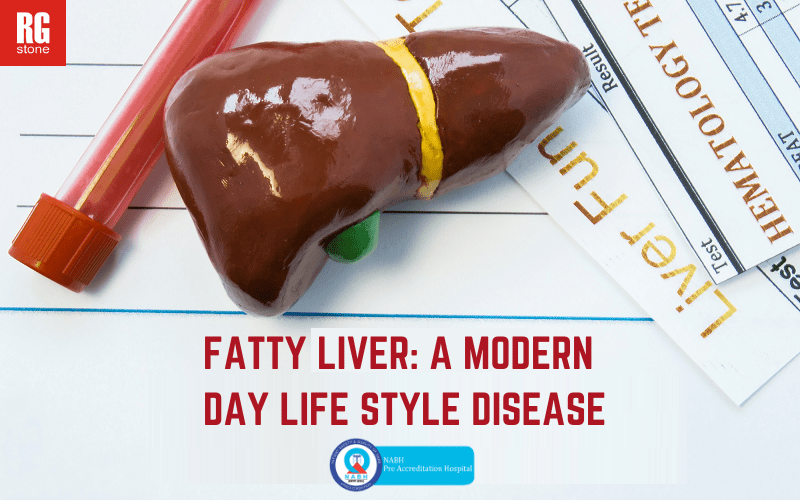What is fatty liver disease?
The liver is the second largest, the multifunctional organ inside our body which helps in digestion, energy storage, and detoxification. A healthy liver contains little or no fat. Fatty liver is a condition in which fat builds up in the liver. There are two main types:
- Alcoholic fatty liver disease: related to the consumption of large amounts of alcohol.
- Nonalcoholic fatty liver disease (NAFLD): related to a wide range of conditions other than alcohol. In fact, routinely used terminology fatty liver is shorthand for NAFLD.
How common is Fatty Liver disease?
It is also projected as one of the leading indications of liver transplantation in the present decade. The increasing incidence of NAFLD is tied to the growing obesity epidemic but not every obese develops fatty liver, and vice versa. Owing to rising childhood obesity, fatty liver is expected to become the leading cause of liver disease and failure, and indication for liver transplantation even in children and adolescents, within the next 10 years.
What are the risk factors for fatty liver?
- Obesity
- Diabetes
- High blood cholesterol
- High blood pressure
- Family history
- Drugs (steroids, anticancer drugs)
- Rapid weight loss/ poor eating habits
- Certain infections (hepatitis C)
What are the stages of fatty liver?
The spectrum of Fatty liver disease can be divided into 4 stages:
Stage 1 (simple fatty liver or steatosis): when fat accounts for more than 5 to 10 % of the liver’s weight without any inflammation or liver cell damage. It is one of the most common forms of reversible, harmless liver disease, with an estimated 30-40% prevalence in India. There are usually no symptoms and diagnosed incidentally.
Stage 2 (Non-alcoholic steatohepatitis, NASH): This means when the liver gets inflamed along with fat accumulation. Around 5-8% of the Indian population has NASH. NASH is a more aggressive form. A person may have a dull or aching pain in the top right of the abdomen or fatigue.
Stage 3 (Fibrosis): When the healthy liver tissue is replaced by fibrous scar tissue.
Stage 4 (cirrhosis or chronic liver disease): the most severe irreversible stage, bands of scar tissue develop, liver shrinks, becomes hard, functions less and leads to liver failure.
Apart from these, fatty liver can lead to liver cancer in a few circumstances.
How can Fatty Liver be diagnosed?
Fatty liver is often diagnosed incidentally when ultrasonography picks excessive fat content in the liver or routine blood tests show raised liver enzymes (ALT/AST) signifying ongoing inflammation in the liver. At-risk persons should get liver function tests and ultrasonography of the upper abdomen regularly.
Once the fatty liver is diagnosed, a newer technique called fibroscan/ transient elastography, which measures the liver’s stiffness, can help in the staging of fatty liver disease. Greater stiffness suggests greater scarring. A liver biopsy may be recommended if tests are inconclusive.
What are the treatment options for non-alcoholic fatty liver disease?
Diet, Exercise, and Healthy Lifestyle are the first and foremost treatment options.
- Gradual weight reduction (>10% of baseline) can remove some fat from the liver
- Eat a healthy diet with lots of fruits, vegetables, and whole grains, limiting salt and sugar.
- Do daily moderate-intensity exercise such as walking or cycling, at least 150 minutes a week. All types of exercise can help improve NAFLD, even if you don’t lose weight.
- Use cautiously dietary supplements, vitamins, or herbal remedies as these can damage the liver.
According to the latest American and European Liver society guidelines, no specific drug therapy can be firmly recommended for NAFLD at present.
What is the long-term prognosis of fatty liver?
The progression rate of simple fatty liver to advanced disease is low, and it may go away with simple lifestyle modification. But that doesn’t mean it’s not a serious condition as few people can eventually develop stage 2 disease.
In patients diagnosed with stage 2 fatty liver disease i.e. NASH, there are about 25% chances of developing cirrhosis within a decade and of this, about 50% will develop liver failure with the survival rate of no more than two years. So here is the importance of lifestyle changes at early stages to prevent the disease from getting worse.
To summarize, fatty liver is plaguing our modern society in parallel with other common lifestyle diseases. It is not a single entity rather a sequential spectrum of stages, out of which simple fatty liver is the most common earliest reversible phase which can be taken care of by lifestyle modification and weight loss; else it can progress to liver cell damage in 10- 25 % from where there is no turning back. Hence ‘ an ounce of prevention is worth a pound of cure’ holds true for fatty liver.



